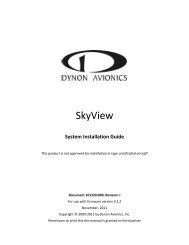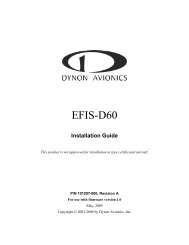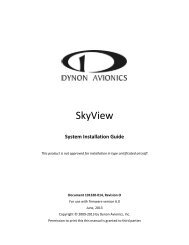EFIS-D100 Installation Guide - Dynon Avionics
EFIS-D100 Installation Guide - Dynon Avionics
EFIS-D100 Installation Guide - Dynon Avionics
Create successful ePaper yourself
Turn your PDF publications into a flip-book with our unique Google optimized e-Paper software.
Appendix<br />
Appendix C: HS34 <strong>Installation</strong> and Configuration<br />
If you purchased an HS34 from <strong>Dynon</strong> <strong>Avionics</strong>, read through this section for details on its<br />
physical and electrical installation. It describes the pinout, mounting information, and some<br />
common wiring connections.<br />
WIRING<br />
Follow these instructions explicitly as improper wiring can result in permanent damage to your<br />
instrument, other connected equipment, or both. Read through the Recommended Wiring<br />
Practices section on page 2-1 before proceeding.<br />
Harness Construction<br />
Because the HS34 interfaces with such a wide variety of NAV radios and GPSs in different<br />
combinations of configurations, <strong>Dynon</strong> <strong>Avionics</strong> does not supply pre-manufactured harnesses for<br />
the HS34. Instead, your HS34 shipped with enough connectors and pins to generate a wide<br />
variety of harness configurations. Refer to the Pinouts and Function Description and Common<br />
Device Connections sections below for detailed wiring information.<br />
If you do not own a D-sub machined-pin crimping tool, they can be obtained for under USD$50<br />
at www.bandc.biz (P/N RCT-3), www.steinair.com (P/N SAT-004), and many other tool<br />
retailers. You may also find it helpful to own a pin insertion/extraction tool, part numbers DSE-1<br />
and SAT-023, respectively.<br />
Power Requirements<br />
22 AWG wire is normally sufficient for the power supply and<br />
ground lines, but you should consult a wire sizing chart and<br />
determine the size required for your routing length. Make sure you<br />
protect the power lines with either a circuit breaker or an<br />
appropriately sized fuse for the wire you select. Power is fed to the<br />
HS34 via pins in the male DB25 connector on the back of the<br />
instrument.<br />
The HS34’s power requirement is 2 watts typical and 3 watts<br />
maximum. On a 12-volt system, this translates to about 0.25 amps<br />
of maximum current draw. On a 24-volt system, this translates to<br />
about 0.13 amps maximum current draw. Normally, a 0.5-amp<br />
circuit breaker or fuse is sufficient.<br />
Connector Description<br />
The HS34 has two DB25 connectors on the rear of the instrument:<br />
one male and one female. All references to connector gender in<br />
this guide are used to describe the connectors on the back of the<br />
HS34, not your harnesses. When building harnesses for the HS34,<br />
make note of the fact that the pin order for the male connector is the<br />
opposite of the order for the female connector. Small pin numbers<br />
can be found next to each pin on both the instrument’s and<br />
harness’s connectors.<br />
7-10 <strong>EFIS</strong>-<strong>D100</strong> <strong>Installation</strong> <strong>Guide</strong>
















